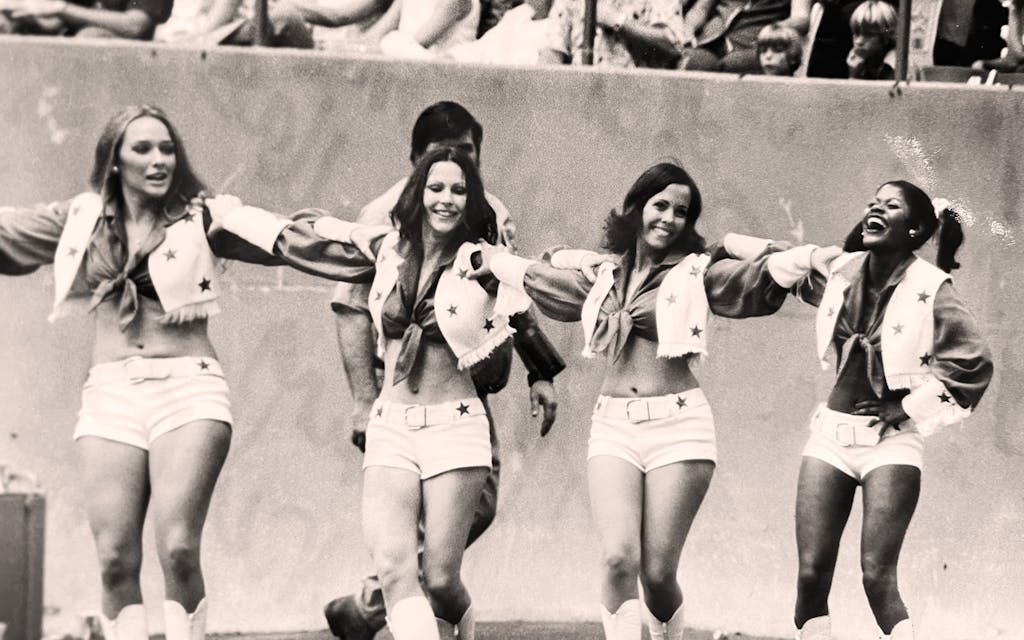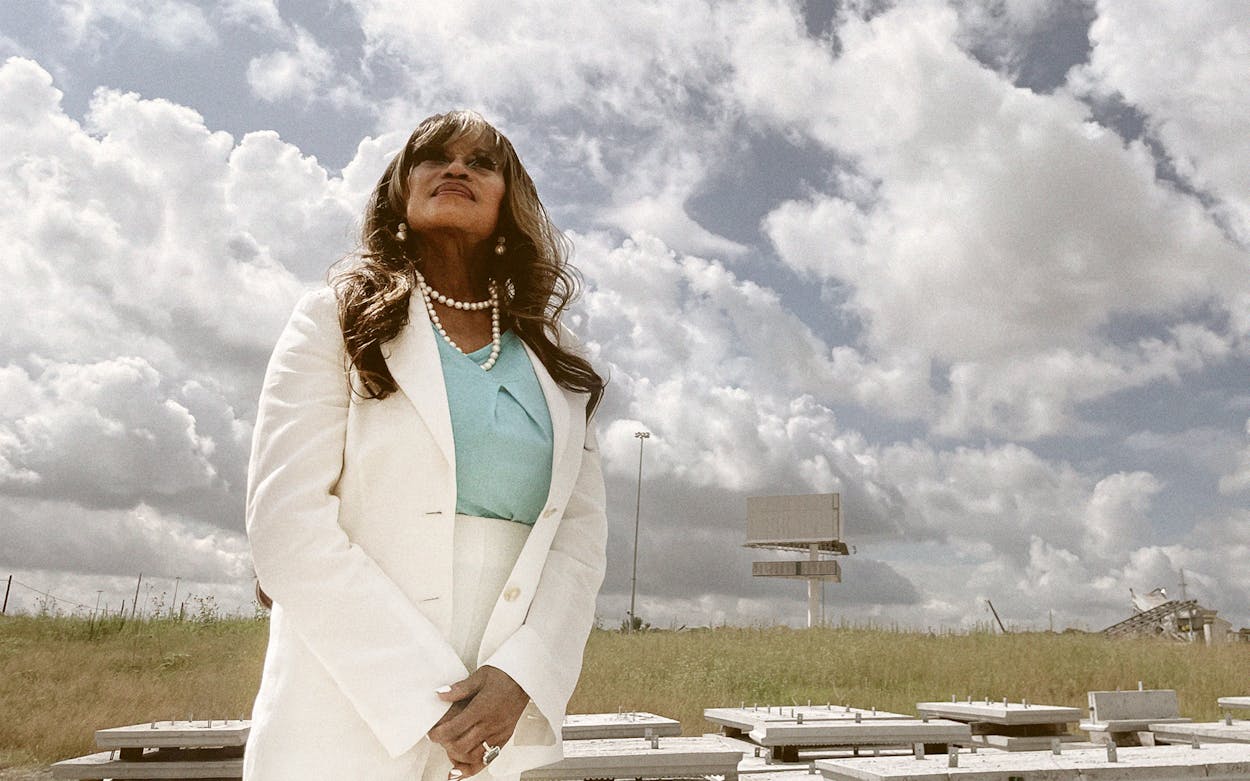Stories in this article are featured in episode one of our podcast America’s Girls. You can dive deeper into the stories from the show in our Pocket collection.
Subscribe
I first met Vonciel Baker in the lobby of a recording studio in North Dallas that I had booked for an interview. I was running behind schedule, as I often am, and I opened the front door to find her perched elegantly on the couch in glitter-encrusted heels. I was in jeans and a T-shirt. Vonciel was in a white sweater with white pearls, and a silky blue skirt that matched her eyeshadow perfectly.
I grew up watching the Dallas Cowboys Cheerleaders, but I couldn’t really tell one from another. They were a blur of beauty and hair and spangles, but I could easily pick out Vonciel. As one of a handful of Black cheerleaders, she stood out. She had eyes like Diana Ross. But her signature feature was a gap between her front teeth that I always found quite pretty.
Vonciel grew up in South Dallas, one of five children born to a single mother. Her mom Bertha has a fascinating tale: she lost her own mother to the Spanish flu in 1918, and later worked as a maid in the Texas town of Kilgore before moving to Dallas, where she helped build planes during World War II. After having children, Bertha opened the city’s first licensed Black day care in their home.
As a girl, Vonciel loved to watch those dancing shows on television like Shindig! and Hullabaloo. She would dance in the living room and dance in the bedroom she shared with her sister, and when her bedroom was occupied, she rode her bike to the park and danced there. Dallas was slow to integrate, and Vonciel went to all-Black high school, where she tried out for cheerleader three times and didn’t make it. (“Too skinny and not attractive enough. That’s what was said to me.”) She joined ROTC instead. She loved the marching, the discipline, the uniform. She went to Texas Lutheran University, where she tried out for cheerleader again, and became the first Black cheerleader in the college’s history.
Then in 1972, at the age of twenty, she heard a radio spot on the popular local station KVIL that said the Dallas Cowboys were holding auditions for a new kind of cheerleader. These cheerleaders would be more like dancers. A hundred young women showed up, but only seven burst onto the field that first day in August 1972. Vonciel was one of them.

She was on the squad for eight seasons, from 1972 to 1981, with a one-season break to have a son named Kinny. After nearly half a century, Vonciel still holds the record for longest tenure in the squad’s history. I knew from interviews that she didn’t like to talk about her age, and I wondered if it had anything to do with a 1980 Dallas Morning News profile of her with the headline “The Oldest Living Cheerleader” (she was 28). Perhaps that wasn’t the title she wanted to hold. She has another claim to fame. She was the first cheerleader ever to try on a uniform that would wind up in the Smithsonian.
Before the season started in summer 1972, she’d taken the bus to her fitting at a clothing store called Lester Melnick, and she was so nervous about being late, she showed up hours early. She sipped tea in the waiting room, reading a book, until a woman asked if she’d like to try on her new uniform. “And I was walking on cloud nine all day when I went home,” she told me.
There are a lot of stories you don’t have room for in a podcast that spans fifty years. Here’s one: Vonciel’s younger sister Vanessa joined the Dallas Cowboys Cheerleaders in 1973, making them two of the first sisters on the team. Vonciel is a bit shy, but Vanessa is outgoing, and she became one of the early leaders on the squad. In 1977, Vanessa received her master’s degree on the field at a game, after then-director Suzanne Mitchell found out she had to skip graduation. And part of me thinks, “Oh, how cool.” And part of me thinks, “Well, that was a very clever staged moment to prove the cheerleaders were more than eye candy.”
By 1977, Mitchell was playing defense against criticism of the cheerleaders as sex objects. “People want a clean, American, apple-pie image,” she often said, even though 1977 was the same year the cheerleaders’ sultry poster became a best-seller. General manager Tex Schramm had leaned over the light table with photographer Bob Shaw and said, of the picture that was eventually chosen: “Now, that’s a come-hither look.” So the cheerleaders were both of these things—American as apple pie, with come-hither looks. And Mitchell had to deflect a lot of criticism as the squad’s profile rose. In a 1977 interview with People magazine, she said, in her typically blunt style, “They are not all pretty in the classic sense. Some are flat-chested, or have big fannies or gaps in their teeth.”
And so that last one—that would be Vonciel (who is actually pretty in the classic sense). I was slightly disappointed to find that Vonciel had fixed the gap, shortly after leaving cheerleading. She’d become a flight attendant for Southwest Airlines, and she told me that spit and food would sometimes fly between the gap while talking to passengers; it was a work hazard. But I couldn’t help suspecting a certain self-consciousness behind the decision. I pointed to a mole on the right side of my cheek that I spent much of my childhood covering with my hands. For so long, I wanted to get that mole removed. “No, no, no. It’s gorgeous,” she said. “I mean, some people draw them on their face and you got it natural.” I told her I thought the same thing about the gap in her teeth. I found it so beautiful, and maybe I shouldn’t have said that (since it was gone), but I did. She told me that years ago, doing the Jerry Lewis telethon with the cheerleaders, she met Johnny Carson, who had said to her, “Oh, you got the Lauren Hutton gap.”


Vonciel is much smaller in person than I expected. Many cheerleaders are. Unlike the Rockettes, who have a height requirement (between five six and five ten), the Dallas Cowboys Cheerleaders I met ranged anywhere from four feet eleven to six feet. They loom larger than life on billboards and posters, but Vonciel was exactly my height: five two. On that first day in the studio, she said to me, “You’re a squatty body.” And lest that sound insulting, she quickly explained that the cheerleaders were split into four groups according to height, and a taller cheerleader had once dismissively referred to Vonciel’s group as Squatty Bodies, a name they proudly embraced. Two other seventies cheerleaders I grew quite fond of, Tami Barber and Shannon Baker, were also Squatty Bodies. And so this became Vonciel’s nickname for me. Whenever I called her (she does not text), she would answer the phone, “Heeeey, Squatty Body!” When I shared this story with friends, they would sometimes cringe, perhaps knowing that I’ve been self-critical about my height and weight most of my life, and “squatty” is not exactly the description most of us are reaching for in this life. But I saw it as a badge of honor. Vonciel Baker, Tami Barber, Shannon Baker—these are some of the most legendary cheerleaders of the late seventies, and I was an honorary part of their group.

It was my podcast producer Patrick Michels’s idea to take Vonciel to the old site of Texas Stadium, the longtime home of the Dallas Cowboys and the place where the cheerleaders debuted. This would become the opening of our podcast, though we didn’t know it at the time. The stadium was torn down eleven years ago, and it had languished as some kind of Department of Transportation staging area for a construction project. I’d driven out a few days earlier to find dirt mounds and detritus, scattered poles and piles of broken cement. I told Vonciel to wear sneakers, because I remembered her glitter heels at the studio, and she showed up in white jazz shoes and a crisp white suit.
“I don’t have any sneakers,” she said.
That morning threatened to rain, but the sky cleared by the time I drove her to the site, and a cool breeze trickled across the late July day. The ground rumbled beneath my tires as I headed toward a spot on the perimeter. I snapped pictures of Vonciel standing on slabs of concrete and staring out at the apocalyptic landscape. Not far from us, a guy sat in his tractor, and big trucks groaned back and forth. I kept waiting for someone to stop us, or ask what we were doing—but nobody did. In that crisp white suit, Vonciel looked very official. She looked like someone who had permission.
I set out folding chairs, and the two of us sat side by side, time-traveling back to the beginning as the clouds moved swiftly overhead. She remembered the hordes of cars that once filled the lot where we now sat. She remembered the smell of popcorn and pretzels, and waving to the people who sold hot dogs at the stand inside; she knew them by name. By the end of its run, Texas Stadium was kind of a dump, but in 1972 it was like a grand ship rising up on the flat and drab North Texas horizon. It had luxury suites, and a hole in the roof that was actually a design flaw (they’d run out of money), but that hole became a signature feature. “So God can watch his favorite team,” Cowboys linebacker D. D. Lewis once quipped. This is where the Cowboys became America’s Team. This is where Vonciel and six other women stepped onto the Astroturf in a blue halter top and white hot pants and go-go boots and changed culture.
Vonciel looked up at the sky as we spoke, the same endless sky she used to see when she stood in that tunnel before the game. The sky that brought rain, and snow, and blistering summer heat, and the cheerleaders learned to dance in all of them.
“I can feel it,” Vonciel said when we arrived.
“What can you feel?” I asked. I loved Vonciel’s voice. It sounded like Texas to me.
She looked out at the rubble. “I can feel the presence of what happened here.”
Listen to the first episode of America’s Girls on Apple Podcasts, or wherever you get your podcasts.
Dive deeper into the stories in this episode in our Pocket collection at getpocket.com/texas. You’ll find videos and news stories about the cheerleaders, plus stories about Dallas’s swinging seventies, and the creation of the TV show Dallas.
- More About:
- Sports
- Dallas Cowboys Cheerleaders
- Dallas






